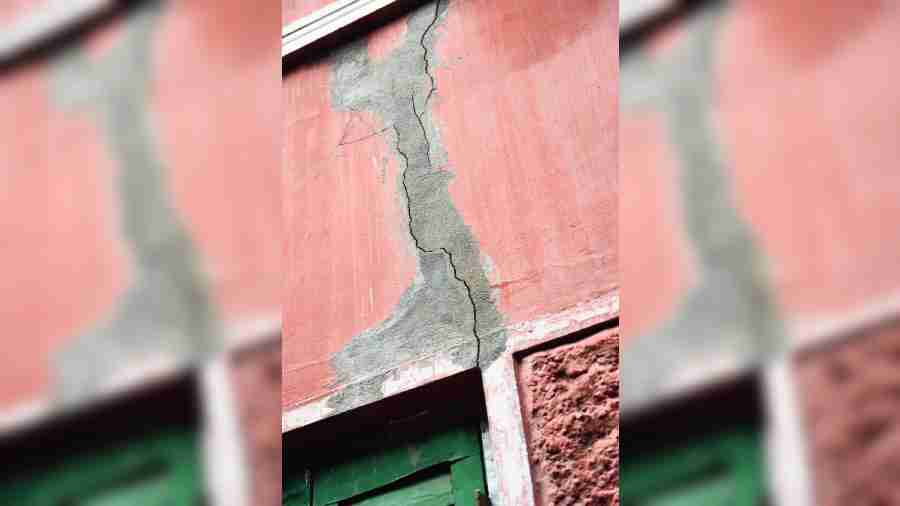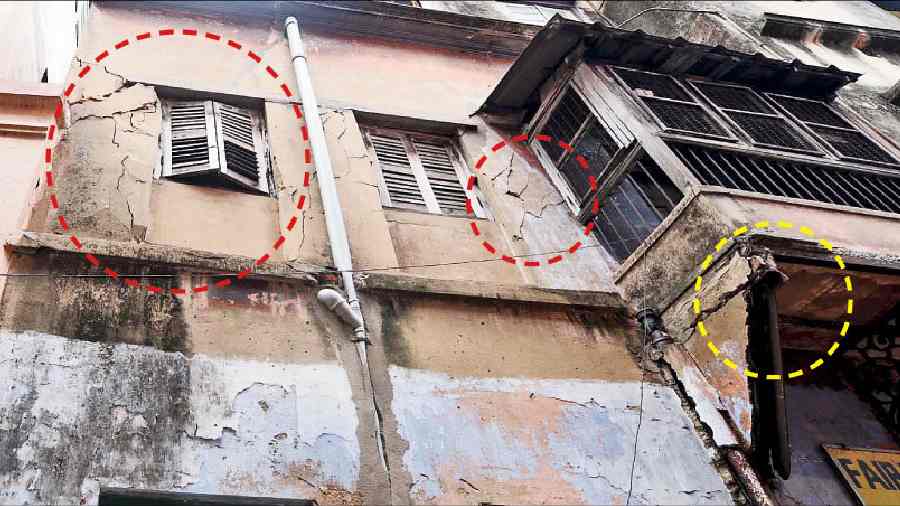Excavation of soil to grout a “blind spot” under the Howrah-bound tunnel of East-West Metro led to leakage of underground water that in turn caused subsidence and cracks in buildings near Bowbazar on Wednesday night, engineers involved in the project said on Thursday.
The cracks displaced at least 110 people, the second time in less than three years. Railway officials said severe cracks had developed in nine buildings, rendering them unlivable.
Kolkata Municipal Corporation officials, however, said 13 buildings were damaged.
The construction of a concrete box inside a shaft — through which the tunnel-boring machines were taken out — led to the water leakage, said an official of the Kolkata Metro Rail Corporation, implementing agency of East-West Metro, which will connect Howrah Maidan and Sector V.
Engineers said there were two ends of the retrieval shaft. The two circular tunnels are linked by a box — being built inside the shaft — with two types of structures. The external structure is temporary and it contains a permanent one.
“The box from the Sealdah-bound tunnel was constructed first and the tunnel boring machine broke through. All the arrangements… were made in advance,” said Naresh Chandra Karmali, director (projects). KMRC.
He said the construction of the box linking the two tunnels was not planned till the subsidence in the Bowbazar area in August 2019, which caused cracks in a number of buildings and led to the evacuation of more than 250 people.
Back then, the Howrah-bound tunnel-boring machine (TBM) had become defunct after hitting a sand aquifer. The tunnel-boring work was completed by the machine in the other tunnel, which took a U-turn in Sealdah.
“We had to build the retrieval shaft at Bowbazar to bring out the TBMs. A reinforced concrete box is being cast inside the shaft to link the two tunnels,” said Karmali.
“The exterior structure of the box could be built only up to the crown of the tunnel. We cannot build something below the tunnel. To that extent, it is a vulnerable location,” he said.
“So, we have grouted the blind area so that it could prevent the ingress of water. One doesn't know what is happening in the soil…. The bottom level of the slab is nearly 21.5m below the crown. We were digging another 500m so that we could have another layer and then build the box. While that excavation was going on, the seepage happened.”
The length of the retrieval shaft is 38m. The box, being built from the Sealdah side, was completed up to 29m, said another KMRC official.
“From the Sealdah side, 29 metres have been built. The structure is made up of a base, walls and roof. We had finished 29m of the base slab. That portion is safe. The damage was done while building the remaining 9 metres.”
Karmali said the rain over the past few days could have led to a rise in the underground water level.
At a news conference on Thursday, C.N. Jha, managing director of KMRC, said due precautions were taken. “But this happened unfortunately. Trying to stop water ingress as soon as possible,” he said.
The Telegraph spoke to Leonard John Endicott, the British engineer who headed the committee of international experts appointed by the KMRC to steer the project after the 2019 accident.
Endicott said the new accident came as a “big surprise” to him.
“The work at the shaft has been regularly monitored and the readings have been sent to me for review. As far as I know, the work at the shaft was carried out in accordance with the designers’ requirements and is nearing completion. I am currently working overseas… I do not have first-hand knowledge of what has happened,” said Endicott.
Mayor Firhad Hakim said KMRC should have intervened before the accident. The state government will meet KMRC officials, he said.





